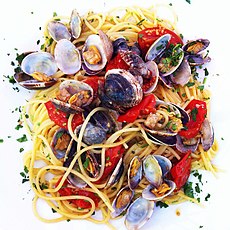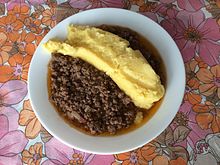
Swiss cuisine is an ensemble of national, regional and local dishes, consisting of the ingredients, recipes and cooking techniques developed in Switzerland or assimilated from other cultures, particularly neighboring countries. The diversity and comprehensiveness of Swiss gastronomy reflects the linguistic, cultural and geographical diversity. The climate of Switzerland allows for a large variety of terroirs, and therefore a wide range of indigenous food, from simple cereals to refined products like cheese and wine.
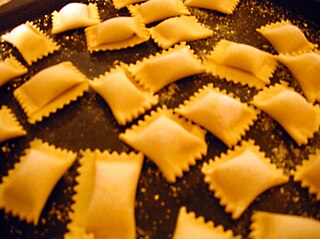
Agnolotti is a type of stuffed pasta typical of the Piedmont region of Italy, made with small pieces of flattened dough folded over a filling of roasted meat or vegetables. Agnolotti can be di magro or di grasso depending on their filling of vegetables or meat.

Parmigiana, also called parmigiana di melanzane, melanzane alla parmigiana or, in the United States, eggplant parmesan, is an Italian dish made with fried, sliced eggplant layered with cheese and tomato sauce, then baked. The origin of the dish is claimed by the Southern regions of Calabria, Campania, Apulia and Sicily. Other variations found outside Italy may include chicken, veal, or another type of meat cutlet or vegetable filling.

Ossobuco or osso buco is a specialty of Lombard cuisine of cross-cut veal shanks braised with vegetables, white wine, and broth. It is often garnished with gremolata and traditionally served with either risotto alla milanese or polenta, depending on the regional variation. The marrow in the hole in the bone, a prized delicacy, is the defining feature of the dish.
Pasquale Carpino was a popular television chef in Toronto and an operatic singer.
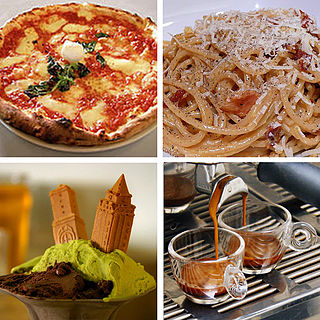
Italian cuisine is a Mediterranean cuisine consisting of the ingredients, recipes and cooking techniques developed in Italy since Roman times and later spread around the world together with waves of Italian diaspora. Some of these foods were imported from other cultures. Significant changes occurred with the colonization of the Americas and the introduction of potatoes, tomatoes, capsicums, maize and sugar beet—the latter introduced in quantity in the 18th century. It is one of the best-known and most appreciated gastronomies worldwide.

Piedmont wine is the range of Italian wines made in the region of Piedmont, in the northwestern corner of Italy. The best-known wines from the region include Barolo and Barbaresco. They are made from the Nebbiolo grape. These wines are ideal for storage and a well-aged Barolo for instance may leave a feeling of drinking velvet because the tannins are polished and integrated more and more into the wine. As the wine matures the colour becomes more brownish and rust-red.

Neapolitan cuisine has ancient historical roots that date back to the Greco-Roman period, which was enriched over the centuries by the influence of the different cultures that controlled Naples and its kingdoms, such as that of Aragon and France.

Timballo is an Italian baked dish consisting of pasta, rice or potatoes, with one or more other ingredients included. Variations include the mushroom and shrimp sauce timballo Alberoni, named after Giulio Alberoni, and the veal and tomato sauce timballo pattadese.

Tagliolini is a type of ribbon pasta, long like spaghetti, roughly 2–3 mm wide, similar to tagliatelle, but thin like capellini. It is a traditional recipe in the Molise and Piedmont regions of Italy. In Piedmont it is called tajarin and made of egg dough. The dough also contains semolina, flour and salt. It is typically served with butter and truffles or sugo d'arrosto, a sauce made from the drippings of roast meat. Tagliolini have a short cooking time, especially when made from fresh dough, and work best with light sauces, fish, delicacies or soups.

Venetian cuisine, from the city of Venice, Italy, or more widely from the region of Veneto, has a centuries-long history and differs significantly from other cuisines of northern Italy, and of neighbouring Austria and of Slavic countries, despite sharing some commonalities.

Italian meal structure is typical of the European Mediterranean region and differs from Northern, Central, and Eastern European meal structure, though it still often consists of breakfast (colazione), lunch (pranzo), and supper (cena). However, much less emphasis is placed on breakfast, and breakfast itself is often skipped or involves lighter meal portions than are seen in non-Mediterranean Western countries. Late-morning and mid-afternoon snacks, called merenda, are also often included in this meal structure.

Bolognese sauce, known in Italian as ragù alla bolognese or ragù bolognese, is a meat-based sauce in Italian cuisine, typical of the city of Bologna. It is customarily used to dress tagliatelle al ragù and to prepare lasagne alla bolognese.
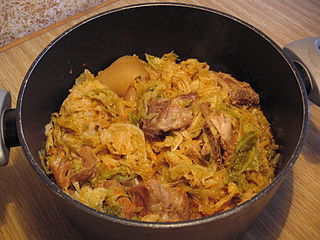
Lombard cuisine is the style of cooking in the Northern Italian region of Lombardy. The historical events of its provinces and of the diversity of its territories resulted in a varied culinary tradition. First courses in Lombard cuisine range from risottos to soups and stuffed pasta, and a large choice of second course meat or fish dishes, due to the many lakes and rivers of Lombardy.

The traditional cuisine of Abruzzo is eclectic, drawing on pastoral, mountain, and coastal cuisine. Staples of Abruzzo cuisine include bread, pasta, meat, fish, cheese, and wine. The isolation which has characterized the region for centuries has ensured the independence of its culinary tradition from those of nearby regions. Local cuisine was widely appreciated in a 2013 survey among foreign tourists.

Ligurian cuisine consists of dishes from the culinary tradition of Liguria, a region of northwestern Italy, which makes use of ingredients linked both to local production, and to imports from areas with which, over the centuries, the Ligurians have had frequent trade.

The cuisine of Basilicata, or Lucanian cuisine, is the cuisine of the Basilicata region of Italy. It is mainly based on the use of pork and sheep meat, legumes, cereals and vegetables, with the addition of aromas such as hot peppers, powdered raw peppers and horseradish. The local gastronomy is, for historical-cultural reasons, typically peasant, based on simple recipes and on the culture of reuse, in particular of meat and bread.
Batsoà is an ancient dish from the Piedmont region of Italy. It was traditionally made from fried pig's trotter. The name of the dish originally comes from the French bas de soie, meaning 'silk stockings', referring to the tenderness of the meal.

